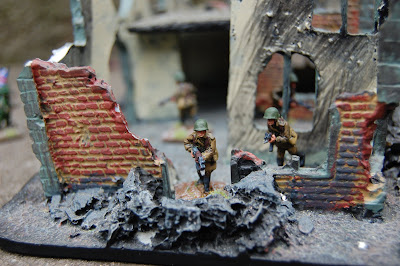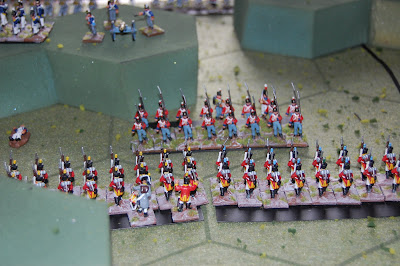I have two projects looming large at present - a large scale Napoleonics game and a LARP both of which are due to run in October. Blessed as I am with large amounts of free time, I've been taking a leisurely approach to both projects using the "not giving a damn" method. What I'm currently excited about is my little Cold War project, specifically the BAOR versus the Soviets around Hanover in the early Eighties.
Naturally as there is no deadline associated with this project, it's the one I'm most interested in pressing on with. I don't know why, put it down to the natural contrariness of human nature, my own mercurial temperament or what have you. The figures are already bought, what is really exercising me at present is the question of terrain.
Force on Force uses a small board, but typically takes place in a built up area so I shall have to make or buy some buildings. Many Cold War games that I have seen use buildings from the players Second World War collections and I'm not particularly interested in that. I was thinking about it last night and I've realised that what I really need to work on is.
1) One or two key buildings that tie the board down to a time and place. I was thinking a filling station and possibly bill boards, neither of which feature highly on Second World War boards.
2) Cars. Modern cities are build for the automobile. As Dashiell Hammet once wrote, "I bought a car so that I could read Los Angeles in the vernacular." This is not quite such an issue in Europe as it is in America, but the addition of several dozen toy cars of appropriate vintage would do a lot of the work for me.
But that's not really what I wanted to write about in this post.
I am old fashioned. I like corduroy. I smoke a pipe. I live in a house that was built in 1882. Mrs Kinch and I were married using the 1877 marriage service*. I like GA Henty, John Donne and Lady Butler. Mrs Kinch often refers to me as a "19th century boy" (see above).
On the other hand, I live in the future - I go to work in composite body armour and carry a chemical weapon. I get most of my news from a pocket device, which I also use as a notebook and a camera. I correspond daily with people from different continents. I just finished playing a wargame with a Japanese who lives a world away. I am in some ways absolutely in tune with this lousy modern world.
Last night, I started looking around googlemaps - trying to get a feel for the pattern of settlement around Hanover. I moved around the map and zoomed in and had a look around. I dropped a pin and tried to access Google Street View. I then discovered that I couldn't. I looked around and found that the German government had effectively knocked Google Streetview on the head. I was quite put out by this, I'm surprised in fact by how irritated I was.
I am still astonished by the idea of flying, but I'm put out when I can't navigate the streets of a distant city on iPhone?
My own expectations surprise me.
* "I plight to thee my troth," I still smile whenever I read those words.






























































